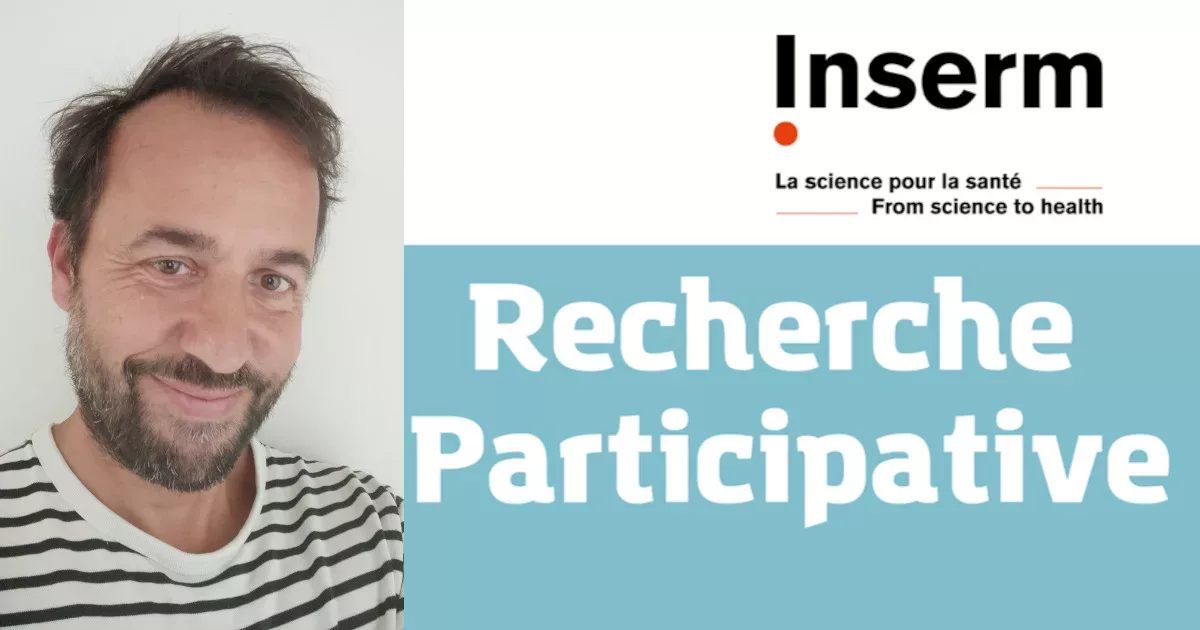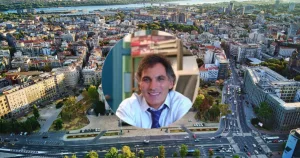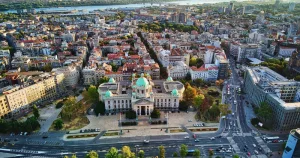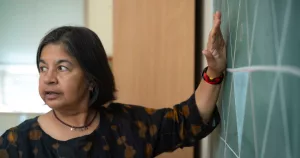Fabian Docagne: “INSERM is doing research with associations and citizens to improve health for everybody”
“A kind of scientific knowledge production in which people from civil society participate actively and deliberately": this definition of participatory science guides Fabian Docagne to develop science and society synergies.

What does citizen participation in research mean for INSERM?
Fabian Docagne: Over the past 20 years or so, INSERM has forged links with patient associations. The institute was a pioneer in France. Following a national trend, driven in particular by the 2020 “Loi de programmation de la recherche” (research national programming law), INSERM has included the implementation of participatory research in its 2025 strategic plan. From the “Charte des sciences et recherches participatives en France”, published in 2017, participatory research is “a kind of scientific knowledge production in which people from civil society participate actively and deliberately”. The aim is to promote the expertise that comes from experience and to make it complementary to academic knowledge. It means giving a voice to this experiential knowledge, owned by the people concerned in the broadest sense: patients, their families and carers, as well as healthcare professionals, paramedical and social professionals, and others. All those who are involved in healthcare, and who may have an opinion to offer.
Beyond meeting legal requirements, what are INSERM’s core motivations for developing participatory research?
F. D.: There is the will to have a science that is more in touch with, and responsive to, society. Firstly, participatory science contributes to a better perception of the scientific process. The Covid crisis showed that a certain segment of the population mistrusts scientists. But on the positive side, it has triggered a huge curiosity in society about what science is doing. Participatory research is a way of responding to both this mistrust and this curiosity. Secondly, it allows us to generate new questions and answers that are better adapted to society’s needs. This is linked to the production of better-quality science: methodologies are co-constructed with the people concerned, they are more adapted, and so we produce better-quality data.
How is this implemented as concrete action?
F. D.: As the head of the Science and Society office, I have three main priorities. The first is to create meeting opportunities for science and society: getting people from different backgrounds to talk to each other, finding a common language, and having a fruitful dialogue. To this end, we are developing communication tools and strategies to enable people to meet and exchange ideas. Especially, we organize meeting and the national and regional scales.
What is the second priority?
F. D.: Funding. Today, the core activity of the department I manage is to set up seed funding. In participatory research, there is a “silent” period, during which we begin to co-construct, before carrying out the research itself. To finance this co-construction, once the projects have been selected, we allocate funding of around €15,000 for a period of 12 to 18 months.
How do you go about it?
F. D.: We take on projects when there’s an idea, or an observation, which may come from an association, civil society, a laboratory, or an exchange between several of these stakeholders. The next step is to transform this idea into a feasible research project, that could generate data and science. Our seed funding enable the stakeholders involved to work together to formulate the scientific questions, and develop the appropriate methodology, which will respect both the requirements of scientific methodology and the realities of the people who will be doing the research. They also plan the project’s mode of governance, the distribution of roles, reporting, and everything else required to ensure that the project runs as smoothly as possible.
How many projects of this type do you finance each year?
F. D.: Half a dozen.
What is this co-construction stage important?
F. D.: It can transform parts of the research project. When scientists design a protocol for a study without leaving their laboratory, it’s not necessarily suited to gathering the observations they’re interested in. For example, a research team working on cognitive aging, in the case of normal aging, and in the case of diseases such as Alzheimer’s disease, had the idea of exploring the memory of stage actors: these professionals tend to have a good memory, or at least good strategies for learning; and they retain their learning abilities well with age. These researchers could have established a study protocol, then recruited actors as subjects, and observed their brains as they learned texts in an MRI scanner. Had they done so, they would certainly have made observations, but far removed from what they really wanted to observe. They spent over a year working with actors to develop a protocol that took account of the real conditions under which they learn their texts, which are very different from those in an MRI scanner, which makes a lot of noise and in which you have to lie still: some actors learn only by walking around the room, for instance.
Beyond adapting the methodology, are there other benefits to co-construction?
F. D.: Some scientific questions from civil society are completely unexpected for scientists. And bringing new questions to light is very valuable in scientific research. For example, in Lyon, a team was working with women suffering from breast cancer. During discussions, these women said they had memory problems, cognitive problems. It has been decided to explore this, and it was shown that these cognitive issues are linked to chemotherapy. It would never have emerged among breast cancer specialists.
INSERM is home to the Groupe de réflexion avec les associations de malades (GRAM), a think tank that brings together researchers, patient association representatives and members of INSERM’s central services. The GRAM is a think tank that brings together researchers, patient association representatives and members of INSERM’s central services.
There is also a Collège des relecteurs: since 2007, INSERM has trained around a hundred volunteers from patient associations to proofread clinical research protocols. The aim is to ensure that what is written is acceptable and feasible. This college is also responsible for editing the instructions given to research participants, to ensure that they are understandable, whatever the person’s situation: age, level of education, fluency in French, physical or intellectual disability. So that informed consent really is informed consent.
Who are your partners in civil society?
F. D.: Associations, but not only. There are also collectives that aren’t necessarily associations. Or even collectives that are created and federated during the project. For example, one team is running a project on teenagers’ mental health. They had decided to co-construct, with teenagers, protocols and questionnaires adapted to their reality. If researchers decide a priori what might be an indicator of good mental health for a teenager, there’s every chance they’ll be wrong: it is more relevant to ask them what it means for them to feel good, or to feel bad. And also, which tools, digital or otherwise, are best to collect the data. The team then created a scalable application, which encourages teenagers who use it to inspire their peers to use it too: a community is built around the project. And unlike a traditional study, the participants are not study subjects: they contribute to the adaptation of the research questions and protocol.
Are non-scientists involved in these projects also concerned by the later stages of research: data analysis, synthesis, publication and communication?
F. D.: It’s not the norm, but we’d like to see it happen more often. It would also be valuable to have the look of the people concerned on the data analysis. But it’s more complex than co-constructing a study. A specific support is required.
Could this go as far as authoring a publication?
F. D.: This is part of good practice. If a member of civil society wishes, following the same rules as for professional researchers, he or she should be an author.
What motivates people to be involved in participatory research?
F. D.: Often, they are concerned by the questions. In the example of the study on teenagers’ mental health, one of the initial questions in the co-construction was what would motivate them to use the application. This could be the possibility of participating in a community on a voluntary basis. The researchers also thought about rewarding participation with invitations to events and meetings with personalities. More generally, we are thinking about how to give value to the work of co-researchers – since it is work – by remunerating them. This is not yet part of French culture, unlike in other countries. And it’s different from a compensation, paid, for instance, to people who agree to be study subjects, in return for their time. In participatory research, there is an intellectual contribution, to the design or realization of a protocol.
Can participatory science have a real impact on the way society works?
F. D.: It can be used to scientifically evaluate empirical interventions. It allows to “scale up”: practices that produce results locally can be developed, with the goal of modifying public health policies. Finally, and this is something I feel very strongly about, it’s an effective tool for innovation. An innovation is defined by its novelty, its adaptation to reality, and its feasibility. To ensure that the creation of a new device, a new drug, or a new intervention does not remain at the invention stage, but is truly an innovation, a good practice is to involve very early on the people who will ultimately be concerned: the people who will receive this innovation or who will dispense it, the patients, their relatives, the doctors, the nursing staff. Participatory research increases the chances for inventions to actually be used to improve everyone’s lives.
You mentioned three priorities in your mission. What is the third?
F. D.: That’s evaluation, which has two sides. The first is to assess whether participatory research is achieving its goals. Does it really work? Is it more democratic? Is there a real contribution to society? Does it really create better science? The second, which is a little more internal to the world of research, is the evaluation of researchers: what is the right way to evaluate this participatory research, which is on the side of conventional research, so that the people who do it are recognized for their effort? When you spend years building a research project with an association, you do not publish or apply for a patent: you don’t fit in with the classic indicators of what professional researchers are asked to do. It is not an easy question to answer.
Do you think more participatory research projects are needed?
F. D.: There could be more. Development is part of our mission, by informing researchers. It should not be mandatory to carry out participatory research, or even to ensure that the level of involvement of civil society is as high as possible in all projects. The approach must benefit the project. It’s not a question of simply giving projects a societal color by adding civil society players who wouldn’t actually be involved. But if funding continues to grow, and a community develops, it will continue to grow.
Interview by Luc Allemand
SUBSCRIBE TO OUR NEWSLETTER
To stay up to date with our projects and the development of the EHC

The Moon & the Global South: Voices, Risks & Promise
Researchers warn that without inclusive governance, the Moon could become “a new arena for old patterns of exclusion” When rockets

Borko Furht: “AI shouldn’t be given much autonomy without maintaining accountability”
Beyond Superintelligence: The Real Challenges of Keeping Humans ‘In the Loop’ Borko Furht is a professor in the department of

The Belgrade Declaration on Science and Art for Sustainability
The Declaration was prepared as the principal outcome of the World Conference on Science and Art for Sustainability, held in

Nalini Joshi: “Mathematics can shape a sustainable future”
Mathematical thinking can drive solutions for climate, energy and many other development issues Nalini Joshi is Payne-Scott Professor of Applied